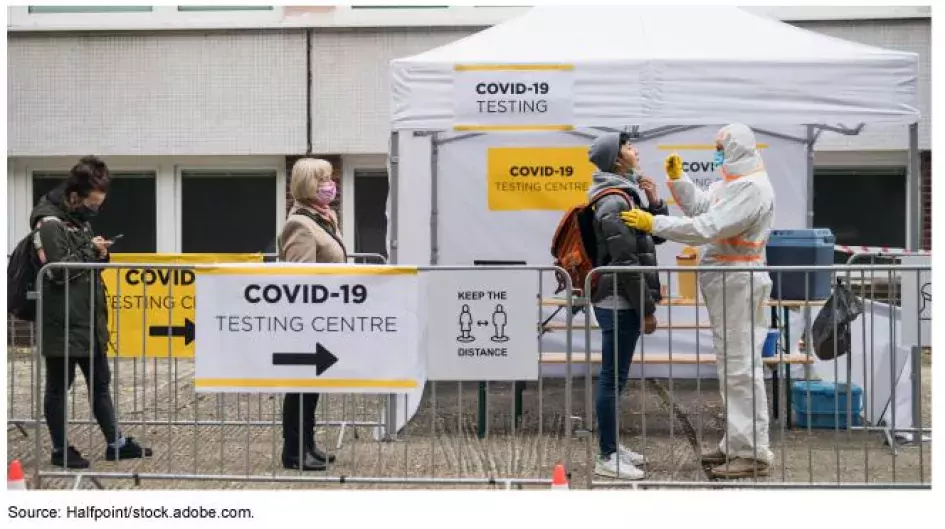How Can the Federal Government Strengthen its Response to the COVID-19 Pandemic?
Deep into the second year of the COVID-19 pandemic, from health care to the economy, challenges remain. Today’s WatchBlog post explores our latest report and recommendations on the federal response to COVID-19.
In our new report, we made 16 new recommendations aimed at continuing to improve the federal response. Among other things, our report looked at federal relief funding for health care providers, recovery funds for state and local governments, potential fraud in the unemployment insurance program, workplace safety, and COVID-19 testing.
Image

Relief funding for health care providers
Congress provided a total of $178 billion under the Provider Relief Fund to reimburse eligible health care providers for expenses related to COVID-19 or revenues lost as a result of the pandemic. As of August 31, the Department of Health and Human Services (HHS) had allocated and disbursed about $132.5 billion of this amount, and had allocated but not yet disbursed about $21.5 billion. The remaining $24.1 billion was unallocated and undisbursed.
We found that HHS’s Health Resources and Services Administration (HRSA)—which oversees the fund—had not established time frames to ensure that its oversight keeps pace with the distribution of those funds to providers.
As a result, we are urging HRSA to establish time frames for completing post-payment audits and to promptly address any identified risks or overpayments made from the fund, such as payments made in incorrect amounts or payments to ineligible providers. HRSA also needs to finalize procedures and implement post-payment recovery of any overpayments, unused payments, or payments not properly used.
Coronavirus State and Local Fiscal Recovery Funds
In March 2021, Congress provided $350 billion to help state, local, tribal, and territorial governments recover from the broad range of costs stemming from the financial effects of the pandemic. The Department of the Treasury is responsible for distributing these funds, and has done so for about $240 billion.
Unfortunately, Treasury has not yet finalized or documented key internal processes and procedures for how it plans to monitor the use of funds. As a result, we recommended Treasury develop timely and sufficient policies and procedures to ensure that recipients are managing their allocations in accordance with laws, regulations, agency guidance, and award terms and conditions.
Unemployment insurance potential fraud
We also have concerns about potential fraud within the pandemic’s unemployment insurance program. In June 2021, the Department of Labor’s Office of Inspector General reported that it had identified nearly $8 billion in potentially fraudulent unemployment insurance benefits paid between March and October of 2020.
Overpayment of unemployment insurance has been a long-standing concern under the regular unemployment insurance program. But while Labor continues to take some steps to address potential fraud, its efforts are not consistent with leading practices we’ve identified. For example, Labor has not clearly designated an entity to oversee fraud risk management activities. As a result, we are recommending, among other things, that Labor designate an entity to lead this effort.
Worker safety and health
The Occupational Safety and Health Administration (OSHA) is responsible for enforcing workplace safety and health standards, but its efforts to do so have faced challenges throughout the pandemic.
For example, workplace safety and health inspectors from area offices said their efforts are affected by lack of resources, effective communication, and timely guidance from OSHA headquarters. As a result, we are recommending that OSHA assess—as soon as feasible and, as appropriate, periodically thereafter—various challenges related to resources, communication, and guidance that the agency has faced in its response to COVID-19, and take action as warranted.
COVID-19 testing
Two types of tests are available to diagnose COVID-19: a molecular test, where results are determined by a laboratory and can take between one and three days, and an antigen test, where rapid results are determined within 30 minutes or less. Antigen tests are increasingly being used to screen for COVID-19. However, the results of these tests, which can be conducted from home, are often not reported.
Since June 2020, HHS has worked to encourage and improve the reporting of antigen testing data to local, state, and federal health officials. However, HHS officials told us that the reporting of antigen test results is incomplete, which prevents HHS from using this testing data to effectively monitor the spread of COVID-19. HHS is taking steps aimed at improving reporting of antigen test data. For example, officials told us that HHS will continue to make enhancements to data reporting by building reporting methods into the testing process, including when antigen testing is used in schools and workplaces.
To find out more about our latest findings and recommendations on the federal response, check out our full report.
- Comments on GAO’s WatchBlog? Contact blog@gao.gov
GAO Contacts
Related Products

GAO's mission is to provide Congress with fact-based, nonpartisan information that can help improve federal government performance and ensure accountability for the benefit of the American people. GAO launched its WatchBlog in January, 2014, as part of its continuing effort to reach its audiences—Congress and the American people—where they are currently looking for information.
The blog format allows GAO to provide a little more context about its work than it can offer on its other social media platforms. Posts will tie GAO work to current events and the news; show how GAO’s work is affecting agencies or legislation; highlight reports, testimonies, and issue areas where GAO does work; and provide information about GAO itself, among other things.
Please send any feedback on GAO's WatchBlog to blog@gao.gov.




